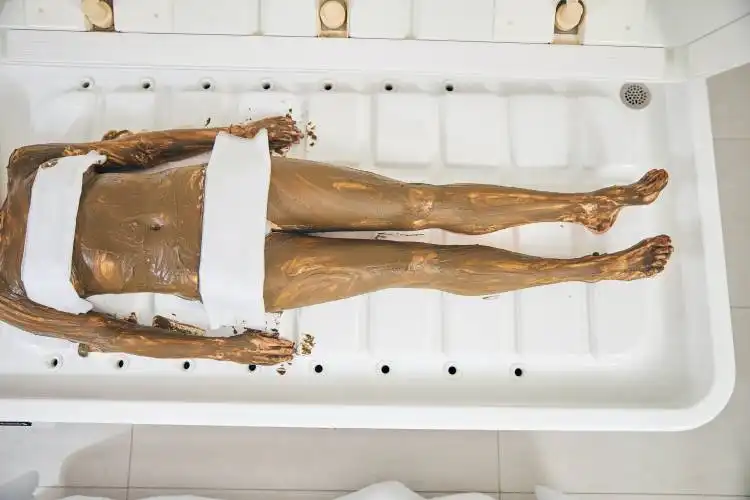Start a Massage Therapy Business
Channeling the Power of Touch: Turning Healing Hands into a Profitable Venture
| Updated


MASSAGE THERAPY BUSINESS
Are your hands strong and your heart tender? A massage therapy business might be the venture for you. This business provides skilled touch and manipulation of the body's soft tissues, treating everything from day-to-day stress to physical injuries. Let your fingers do the talking as you work magic on knots and ease aching muscles, creating a pathway for calm and well-being. Go ahead, turn your healing hands into your bread and butter, kneading clients into a dough of relaxation and serenity.
Jump to Business Plan
RELATED BUSINESS IDEAS
Browse ALL Health & Beauty Innovations Business Ideas
Discover Your Perfect Domain
Unlock the door to your online success with our hand-picked selection of premium domain names. Whether you're starting a new venture or rebranding an existing one, the right domain can set the tone for your digital presence. Browse through our curated list, each with its unique potential to enhance your brand's visibility and credibility.
MASSAGE THERAPY MINI BUSINESS PLAN
This a quick reality check to help you identify the strengths and weaknesses of your business concept before you dive in.
Expected Percent Margin:
- Gross Margin: 70-90%
- Net Profit Margin: 15-30%
Earnings Expectations:
- Daily Earnings: $200 - $700
- Weekly Earnings: $1,000 - $3,500
- Monthly Earnings: $4,000 - $14,000
- Annual Earnings: $48,000 - $168,000
Actions to Hit Those Numbers:
Personnel Management:
- Initial Investment: At least $10,000-$20,000 for professional massage equipment.
- Staff: Employ 1-3 certified massage therapists.
Marketing and Customer Acquisition:
- Social Media: Post 1-2 times a day on platforms popular with your target demographic.
- Local Advertising: Budget at least $200 a month for local online ads or flyers.
Appointments and Customer Experience:
- Online Booking: Implement an online booking system for easier scheduling.
- Repeat Clients: Aim for a high level of repeat clients. Offer package discounts to encourage this.
Cost Control:
- Rent: As the business grows, consider a location where rent is less than 10% of expected monthly sales.
- Utilities and Maintenance: Budget around $200-$400 per month.
Business Operations:
- Open Hours: Open 5-6 days a week, with a wide range of hours to accommodate client schedules.
- Service Volume: Aim for each therapist to perform 4-6 massages per day at typical rates of $50-$120.
Remember, these are generalized estimations and may vary depending on a number of factors. Always consult with a financial advisor for personalized advice.
NOT WHAT YOU HAD IN MIND? Here are more ideas



Browse ALL Health & Beauty Innovations Business Ideas
Grab Your Business Website Name
Before you get caught up in the whirlwind of setting up your business, invest in a domain name. It's a small but significant step that lays the foundation for your brand and makes it easier for customers to find and trust you. Just like you wouldn't build a house without securing the land first, don't build a business without securing your domain name.
"Why? Can't that wait?" Here's why it shouldn't
Step 1: Determine if Starting a Massage Therapy Business is Right for You
Breakdown of Startup Expenses
Before starting a massage therapy business, it is important to have a clear understanding of the startup expenses that will be incurred. This includes the cost of a business license, insurance, equipment, and any other necessary supplies. It is also important to consider the cost of advertising and marketing, as well as any fees associated with setting up a website or other online presence. Additionally, it is important to consider the cost of renting a space for the business, if necessary.
Breakdown of Ongoing Expenses
In addition to the startup expenses, it is important to consider the ongoing expenses associated with running a massage therapy business. This includes the cost of utilities, such as electricity and water, as well as any other necessary supplies. Additionally, it is important to consider the cost of advertising and marketing, as well as any fees associated with maintaining a website or other online presence. It is also important to consider the cost of hiring employees, if necessary.
Examples of Ways to Make Money
There are a variety of ways to make money with a massage therapy business. This includes providing services to clients, such as massage therapy, as well as selling products, such as massage oils and lotions. Additionally, it is possible to offer classes or workshops, as well as provide services to corporate clients. It is also possible to offer gift certificates or packages, as well as partner with other businesses to offer discounts or promotions.
Step 2: Name Your Massage Therapy Business
Brainstorm: Brainstorming is an important part of the naming process. Take some time to think of words that are related to massage therapy and that you think would make a good business name. Consider the type of massage therapy you will be offering, the target audience, and any other relevant information.
Research: Once you have a few ideas, it’s time to do some research. Check to see if the name you’ve chosen is already in use by another business. You don’t want to choose a name that’s already taken or too similar to another business’s name. You should also research the meaning of the words you’ve chosen to make sure they don’t have any negative connotations.
Consider Your Brand: When choosing a name for your business, it’s important to consider how it will fit into your overall brand. Your business name should reflect the type of massage therapy you offer and the values of your business.
Get Feedback: Once you’ve narrowed down your list of potential names, it’s a good idea to get feedback from friends, family, and potential customers. Ask them what they think of the names and if they have any suggestions.
Make it Unique: Finally, make sure your business name is unique. You want it to stand out from the competition and be memorable. Consider using a play on words or a pun to make your business name more unique.
Step 3: Create a Business Plan
Introduction: A business plan is an essential tool for any business, regardless of size. It is a roadmap that outlines the goals and objectives of the business, as well as the strategies and tactics that will be used to achieve them. It also serves as a guide for the business owner to refer to when making decisions.
Market Analysis: A market analysis is a critical component of any business plan. It should include an analysis of the target market, competitors, and the industry as a whole. It should also include an analysis of the strengths and weaknesses of the business, as well as any potential opportunities or threats.
Financial Plan: A financial plan should include a detailed breakdown of the startup costs, ongoing costs, and projected revenue. It should also include a budget for marketing and advertising, as well as any other expenses that may be necessary.
Operational Plan: An operational plan outlines the day-to-day operations of the business. It should include a description of the services offered, the staff needed to provide those services, and any other operational details.
Exit Strategy: An exit strategy is an important part of any business plan. It should include a plan for how the business will be sold or transferred in the event that the owner decides to retire or move on to another venture.
Conclusion: A business plan is an essential tool for any business. It should include an analysis of the target market, competitors, and the industry as a whole. It should also include a financial plan, an operational plan, and an exit strategy. By following these steps, a business owner can create a comprehensive business plan that will help them achieve their goals.
Step 4: Obtain Licensing and Certifications
Licensing Requirements
Depending on the state, massage therapy business owners may need to obtain a business license and/or a massage therapy license. It is important to research the specific requirements for the state in which the business will be operating. Generally, a business license is required to conduct business in the state, and a massage therapy license is required to practice massage therapy. The massage therapy license may require the completion of a massage therapy program, the passage of an exam, and the payment of a fee.
Certifications Needed
In addition to the licensing requirements, massage therapy business owners may need to obtain additional certifications. These certifications may include CPR certification, first aid certification, and/or a certification in a specialty massage technique. It is important to research the specific requirements for the state in which the business will be operating. Generally, these certifications require the completion of a course and the passage of an exam. The cost of the certifications may vary, so it is important to research the cost of the certifications prior to enrolling in a course. Additionally, some certifications may need to be renewed periodically, so it is important to research the renewal requirements for the certifications.
Step 5: Find a Location
- When deciding on a location for your massage therapy business, there are several factors to consider.
- First, you should consider the local market and determine if there is a need for massage therapy services in the area.
- You should also consider the demographics of the area and whether the target market you are trying to reach is present.
- Additionally, you should consider the competition in the area and what type of massage therapy services they offer.
- You should also consider the cost of rent, utilities, and other expenses associated with the location.
- Finally, you should consider the accessibility of the location and whether it is easy for clients to get to.
Finding a Suitable Location
- Once you have considered all of the factors mentioned above, you can begin looking for a suitable location for your massage therapy business.
- You can start by searching online for available commercial spaces in the area.
- You can also contact local real estate agents who specialize in commercial properties.
- Additionally, you can ask friends and family if they know of any available spaces.
- You should also consider looking for shared office spaces that may be available.
- Finally, you should consider looking for spaces that are already set up for massage therapy services.
Step 6: Purchase Equipment
When starting a massage therapy business, there are certain pieces of equipment that are essential for providing massage services. These include a massage table, massage chair, linens, massage oils, and lotions. Depending on the type of massage services you plan to offer, you may also need additional equipment such as hot stone kits, aromatherapy diffusers, and massage guns. It’s important to research the best quality equipment for your budget and make sure that it meets the standards of your local health department.
Where to Buy Equipment
Once you’ve determined the essential equipment you need for your massage therapy business, you’ll need to find the best place to purchase it. Many massage therapists choose to purchase their equipment from specialty massage supply stores, as they often offer the best selection and prices. However, you can also purchase massage equipment online from websites such as Amazon or eBay. Be sure to read customer reviews before making any purchases to ensure you’re getting the best quality equipment for your money.
Cost of Equipment
The cost of massage equipment can vary greatly depending on the type and quality of the items you purchase. Generally, you can expect to spend anywhere from $200-$2,000 on massage equipment. It’s important to factor in the cost of equipment when creating your business budget, as it can be a significant expense.
Financing Options
If you’re unable to purchase the equipment you need for your massage therapy business upfront, there are financing options available. Many massage supply stores offer financing plans that allow you to pay for your equipment over time. Additionally, you may be able to apply for a small business loan or line of credit from your bank to cover the cost of your equipment.
Step 7: Market Your Business
Create a website: Creating a website is a great way to market your business. It allows potential customers to learn more about your services and contact you for appointments. You can also use your website to showcase your portfolio of work and share customer testimonials. Additionally, you can use your website to post blog articles related to massage therapy and health and wellness topics.
Utilize social media: Social media is a great way to reach potential customers and build relationships with your existing customers. You can use platforms like Instagram and Facebook to post updates about your business, share customer testimonials, and promote special offers. You can also use social media to connect with other massage therapists and industry professionals.
Network: Networking is an important part of marketing your business. You can attend industry events and conferences to meet other massage therapists and potential customers. You can also join local business groups and chambers of commerce to network with other business owners in your area.
Advertise: Advertising is another great way to market your business. You can use traditional methods such as radio, television, and print ads. You can also use online methods such as pay-per-click ads, sponsored posts, and banner ads. Additionally, you can use direct mail to send postcards and flyers to potential customers in your area.
Word-of-mouth: Word-of-mouth is one of the most powerful forms of marketing. Encourage your existing customers to spread the word about your business by offering referral discounts and incentives. You can also offer loyalty programs and discounts for repeat customers. Additionally, you can ask your customers to leave reviews on your website and social media pages.
Step 8: Hire Employees
When hiring employees, it is important to consider the skills and experience needed for the job. It is also important to consider the cost of hiring employees and the potential for growth. Consider the type of massage therapy services you will be offering and the qualifications needed for those services. Additionally, consider the number of employees you will need to hire and the hours they will need to work.
Benefits of Hiring Employees
Hiring employees can be beneficial to a massage therapy business. Employees can help with the day-to-day operations of the business, such as scheduling appointments, taking payments, and providing customer service. Additionally, having employees can help to free up the time of the business owner, allowing them to focus on other aspects of the business. Employees can also help to bring in new clients and provide additional services that the business owner may not be able to provide.
Finding Employees
There are several ways to find employees for a massage therapy business. One way is to post job listings on job boards or websites. Additionally, you can reach out to massage therapy schools and ask them to refer qualified candidates. You can also network with other massage therapists in the area and ask them for referrals. Finally, you can reach out to local massage therapy associations and ask them for referrals.
Interviewing Employees
When interviewing potential employees, it is important to ask questions that will help you determine if they are the right fit for the job. Ask questions about their experience and qualifications, as well as their availability and willingness to work. Additionally, ask questions about their customer service skills and their ability to work with clients. Finally, ask questions about their understanding of the massage therapy services you will be offering.
Step 9: Set Prices
The final step in starting a massage therapy business is to set prices for services. It is important to consider the local market and competition when setting prices. It is also important to consider the cost of supplies and overhead when determining the cost of services. Additionally, it is important to consider the cost of labor and the value of the services being provided. It is also important to consider the cost of advertising and marketing when setting prices. Finally, it is important to consider the cost of insurance when setting prices.
Ways to Make Money
When setting prices for massage therapy services, it is important to consider ways to make money. One way to make money is to offer discounts for returning customers or for customers who purchase multiple services. Additionally, offering packages or memberships can be a great way to make money. Another way to make money is to offer add-on services such as aromatherapy or hot stone treatments. Finally, offering gift certificates can be a great way to make money and to attract new customers.
EXPLORE MORE CATEGORIES
Browse ALL Business Idea Categories
TAKE THE NEXT STEPS










